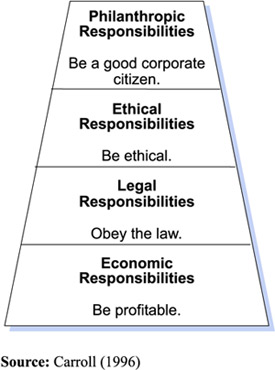
While Corporate Social Responsibility (CSR) has been around since the 1950s, its importance and practice took hold much later. The basis of what we consider to be the modern definition of CSR is rooted in Archie Carroll’s “Pyramid of Corporate Social Responsibility.” In this Pyramid, a corporation has four types of responsibilities. The first and most obvious is the economic responsibility to be profitable. The second is the legal responsibility to obey the laws set forth by society. The third, which is closely linked to the second, is the ethical responsibility. That is to do what is right even when business is not compelled to do so by law. The fourth is the philanthropic responsibility. Also called the discretionary responsibility, it is best described by the resources contributed by corporations toward social, educational, recreational and/or cultural purposes.
Nearly 20 years later the Pyramid remains highly relevant. It is regularly cited, debated, modified and criticized by academia, corporate leaders, politicians and social commentators. But to understand the Pyramid’s true relevance one must look beyond the debate and focus more on its practical application. The Pyramid’s importance persists given its simplistic yet fundamental framework by which any company can not only comprehend the necessary principles of social responsibility, but ultimately set forth the practices to achieve each step of the pyramid with the ultimate goal of reaching the top.
Learn more about how we can help your company with its philanthropic responsibilities, or contact us at info@growyourgiving.org to find out how we can help you be a good corporate citizen.


